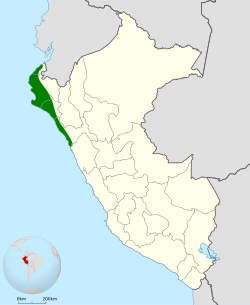| Cinereous finch | |
|---|---|
 | |
| In Contralmirante Villar province, Peru | |
| Scientific classification | |
| Kingdom: | Animalia |
| Phylum: | Chordata |
| Class: | Aves |
| Order: | Passeriformes |
| Family: | Thraupidae |
| Genus: | Piezorina Lafresnaye, 1843 |
| Species: | P. cinerea |
| Binomial name | |
| Piezorina cinerea (Lafresnaye, 1843) | |
 | |
| Synonyms | |
| |
The cinereous finch (Piezorina cinerea) is a species of South American bird in the tanager family Thraupidae. It is the only member of the genus Piezorina. It is found in arid coastal regions of northern Peru, with a single record, presumably a straying bird, from immediately adjacent Ecuador.
